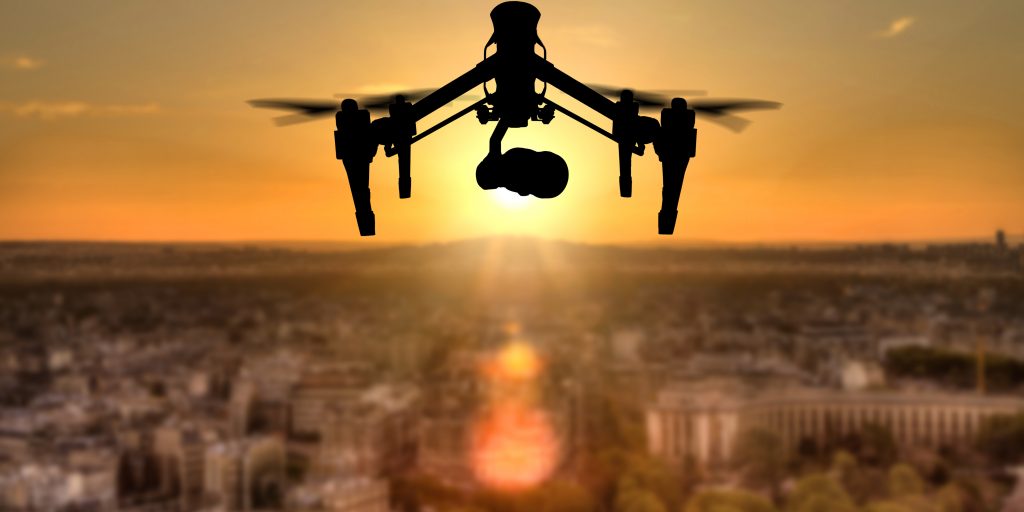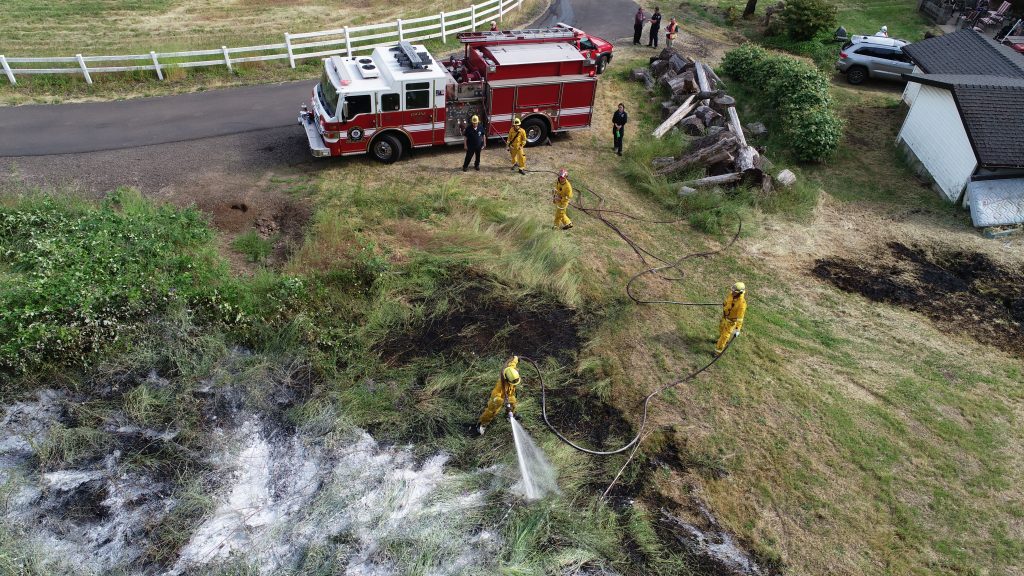Learning to fly
Finding beaver dams was what initially inspired Will Rockwell to demonstrate the capabilities of drones to Vernon Hills, Ill., administrators in 2016.
Beaver dams commonly cause flooding issues along a stream that runs through Vernon Hills. Rockwell, the village’s GIS coordinator, figured that a drone could conduct necessary stream inspections much more efficiently from the air than public works employees could while slogging through mud and brush with equipment.
Rockwell unorthodoxly bought his own drone with his own money to develop the proof of concept. “I had this project in mind, but the village wasn’t just going to give me money to do this. So I just kind of went out and did it,” he says. That project ultimately yielded an interactive, drone video-laden GIS map that showed where blockages were occurring on the stream.
The village’s public works director was so impressed with Rockwell’s proof of concept that he asked the GIS coordinator to use the drone to inspect village facilities’ roofs as well as cell tower equipment. Vernon Hills’s park district came to Rockwell and asked him to fly over its parks to show the public the park amenities present. Rockwell has since done drone-related work for the village’s community development director and code enforcement department by flying around new developments within the village.
Rockwell’s experience in Vernon Hills exemplifies a phenomenon that has occurred at other local governments across the country. Drones may first be adopted with one use in mind, but once the idea of acquiring a drone is floated to other departments, they too, will find uses for it. From there, certain departments can teach other departments how to accomplish feats with drones.
“We were under the understanding too, that as we start [using drones], there’s going to be different applications that we find that would arise… this is just another tool in our tool bank that we can go back to and address those issues where we may not have had the ability or the technology before,” says Adam Graper, director of media relations and technology for Crown Point, Ind., which started its own drone program earlier this year.
This chain reaction of drone uses both increases the cost efficiency of creating drone programs in local government while also improving multiple processes across departments, from accident reconstruction for police and code enforcement for building departments to land surveying for public works and GIS mapping.
Examples abound of local governments using drones in their operations — the devices are currently enjoying increasing use among local agencies across the country.
Soaring in popularity
Drones have hovered around the local government market for some time now. Several public safety agencies experimented with using drones between 2006 and 2014, according to a 2017 informal study on drone use in public safety agencies from Bard College’s Center for the Study of the Drone.
The introduction of affordable and intuitive consumer drones around 2014 however, saw an increase in drone adoption by public safety agencies, the study shows.
“I think when we really saw an increase in agencies was around a boom in consumer drones generally, which was in the mid-2010s, you know, 2015, 2016 and 2017 in particular,” says Dan Gettinger, founder and co-director of the Center for the Study of the Drone, as well as the author of the informal study, titled “Public Safety Drones.”
In April 2017, that informal study found that 347 state and local public safety agencies across the U.S. had acquired drones, based on media reports, Federal Aviation Administration (FAA) records and local government records.
By May 2018, that number had shot up to 910 agencies, the updated study shows. Local law enforcement departments made up two-thirds of the 910 agencies. Based on that number, the number of public safety agencies with drones now more than doubles the number of agencies in the country with manned aircraft.
“There’s only so many state, police helicopters available, and once a town is legally flying a drone, it’s like they have their own personal helicopter,” says David Price, co-founder of Drone Consultant Group, which provides professional FAA drone pilot training, certification, drone sales and drone program consulting services to the public and private sectors.
That added capability opens up a world of possibility for local agencies — even those that already have ample access to manned aviation.
Getting started
Crown Point wasn’t exactly in dire need for aviation assistance when officials began building the city’s drone program earlier this year. The sheriff’s department in Lake County, Ind., which surrounds Crown Point, has had a longstanding aviation unit that Crown Point has been able to access. However, the city is using drones on a more micro level, says Crown Point Fire Department Division Chief Mark Baumgardner, Jr., who also serves as a drone pilot for the city.
Crown Point officials first explored establishing a drone program for public safety issues but soon realized drones in the city should be used for more than just that one area. So, Crown Point’s drone team — which is composed of volunteer city employees — identified potential drone uses to other city departments before making any purchases, according to Nathan Way, general service officer of the Crown Point Police Department and another drone pilot in the city.
“We saw a primary use on the public safety side as a life or death issue, however, we anticipated that there was a use for it throughout the city and all the departments,” Graper says. “So, the individuals we had brought into the [drone] program came in with the understanding that this was not only a venture that would deal with their specific department but maybe require them to work outside their comfort zone, their actual departments and do a larger approach city-wide.”
A similar scenario unfolded across the country for Albany, Ore. Being susceptible to earthquakes, Albany officials initially looked into getting a drone for an effective way to quickly assess if the large bridges and other infrastructure in their community would be salvageable following a dangerous earthquake, says Chuck Perino, Albany’s emergency manager and a drone pilot for the city. Perino’s predecessor had come up with this usage idea, and he handed the nascent program to Perino when the latter started in his role in May 2017.
However, Perino realized that an expensive asset like a drone could be used more frequently than just following dangerous events. He in turn collected input from other city departments that were interested in participating in a drone program.
“We made sure that we brought everybody under the tent whenever we started this,” Perino says. “The fire department has really kind of taken the lead on it, the department that I’m under… We kind of lead the program for the city and support the other departments in any way we can.”
If you build it, they will come
Now, fast-forward to the present. As of Dec. 1, Albany has four drones — the latest, a donation from a local business, has a thermal camera. The city has five trained pilots and eight that are in the process of being trained. Perino says the city bought its first drone in July 2017 but began using drones in earnest earlier this year once pilots were properly certified using FAA guidelines.
So far, Albany has used it in a variety of ways, Perino explains. Albany’s drones have documented the construction of new structures and taken aerial photos of new buildings. The police department has used it to search for missing persons and to support water rescue drills. The parks department has used it to monitor parks and vegetation. Drones are documenting traffic patterns and monitoring the integrity of wastewater and wetlands facilities in the city. As a promotional use, a drone helped monitor what an Oregon newspaper called “the largest Veterans Day parade west of the Mississippi” in the city.
Rockwell has taken a different yet nevertheless successful approach in Vernon Hills. After multiple departments showed interest in his drone over a period of months, Rockwell began flying his drone along circuits to different areas, shooting footage and then uploading the videos and imagery online. From there, multiple departments like code enforcement, public works and community development will use the videos and imagery for their own purposes, he says. His feats have drawn enough positive reception that Vernon Hills will be purchasing its own drone in the upcoming fiscal year.
“It does all of these jobs that people used to do at a higher risk and [with] more time… It just cuts down time for a lot of these departments for a lot of different reasons, and it kind of centralizes the data,” Rockwell says.
In other words, Rockwell can fly a site and in 30 minutes, gather the necessary data for a rooftop inspection, a cell tower inspection, an engineering inspection and a building code inspection that is then converted into a single data deliverable that several departments can use at the same time.
As of Nov. 30, Crown Point’s drone program had been operating only for just over one month, with three FAA-certified pilots flying the drones for the city. However, the city has prepared for a variety of uses for its two drones. The city is now able to search for people, conduct accident reconstructions and obtain information on buildings, infrastructure and land much more efficiently than it was able to previously accomplish, according to Baumgardner.
Getting to that point took some time. as the drone team began meeting with other agencies earlier this year, Baumgardner says. “There’s a lot of paperwork and registrations and trainings you have to do before you can start flying,” he says. “That’s what’s taken up most of our time up until this point.”
It’s a path too, that isn’t always straightforward.
Getting your wings
According to Baumgardner, Perino and Rockwell, drone pilots in their respective cities are certified to fly under the FAA’s Part 107 rule, also called the Small Unmanned Aircraft System (UAS) Rule, which came into effect in August 2016.
Through this rule, drone pilots can only fly after obtaining an FAA Remote Pilot Certification and specially registering the drone through the FAA. They also can only fly under certain restrictions, like weighing under 55 pounds at takeoff (including the payload) and only flying within visual line-of-sight.
It’s a time-consuming certification. Baumgardner says that he, Way and Crown Point’s other pilot took a 60-hour class and then had to pass a test. They will need to retake the test every two years.
According to the FAA’s website, a federal, state or local government office can fly a drone to support a specific mission under the Part 107 rule. However, conducting certain operations would require a government office to apply for a public Certificate of Waiver or Authorization (COA).
Of all services that Price’s Drone Consultant Group offers, he says that certification and training are what he most frequently does for public clients. He says however, that governments should get certified through COAs, which he writes and sends to the FAA for clients. But doing so also has added perks.
“The cool part with a COA is that, now it’s not the individual that’s licensed, now it’s the town that’s licensed, or the government agency,” he says. This in turn transfers risk and liability from an individual pilot to the government itself.
“Imagine that you’re flying under Part 107 as an FAA licensee and you’re a police officer. Well, if you crash it into somebody’s car, now it’s the police officer who’s liable, not the town that they’re flying for. Unless the town really wants to protect them,” he adds.
Another consideration for obtaining COAs is that governments with COAs are expected to train themselves, Price says. COAs must also be applied for. Without COAs or waivers, however, officials cannot for example, fly at night, over people or out of line-of-sight.
There are a few ways to proceed with applying for a COA as far as other agencies are concerned, Price says.
“In one case, there will be one department that owns drone operations for a town,” Price says. “In an ideal situation… I’ll write the COA for the entire town, and I’ll actually train two people from DPW, two people from police, two people from fire, and then the town may go out and purchase two or three drones.”
The latter is preferable, Price says, because costs are shared, and those flying drones within the government can mix with officials in other departments and share their best practices. Public works professionals who know how to survey map with drones can teach police how to do so, since police will be able to use those skills when surveying a crime scene to map it for the court case.
“Of course, police might not have the engineer brain to know how to do really good survey mapping. So, they could learn that from the DPW folks in their own town,” Price says.
This networking to learn how to better use drones extends beyond just inter-agency operating — governments can (and do) network to get better informed on how to create drone programs in general.
Networking to lower net work
Crown Point wasn’t the first government in its area to incorporate drones into its affairs — Valparaiso, Ind.’s police department was one of the first in the area to adopt drones. So, when it came time for Crown Point to draft up its drone use guidelines for the city, officials copied all of Valparaiso’s policies and procedures, while modifying certain parts to better fit Crown Point, Baumgardner says.

Footage captured from A Crown Point, Ind., drone at the National Softball Association’s Word Series.
From there, Crown Point formed a partnership with the Tippecanoe County (Ind.) Sheriff’s Department to exchange information, procedures and tactics.
“The agencies that have drones kind of have formed their own community,” Baumgardner says. “We all face the same limitations, the same obstacles, we are all faced with relatively the same scenarios, so just like everything else we do in public safety, we’ve kind of formed our own little community and we all help each other out.”
Rockwell too, has consulted with multiple governments on the subject. After he gave a presentation on municipal drone use that was posted online, multiple governments in Illinois reached out to him about creating drone programs in their communities. Meanwhile, Perino leveraged information and contacts from the Naval Postgraduate School — where he obtained his master’s degree — to determine best practices for Albany’s drone use and drone policy.
“Build a network of agencies that are using this stuff,” Way advises. “If we all work together, we can come up with more efficient uses and help each other out.”






















